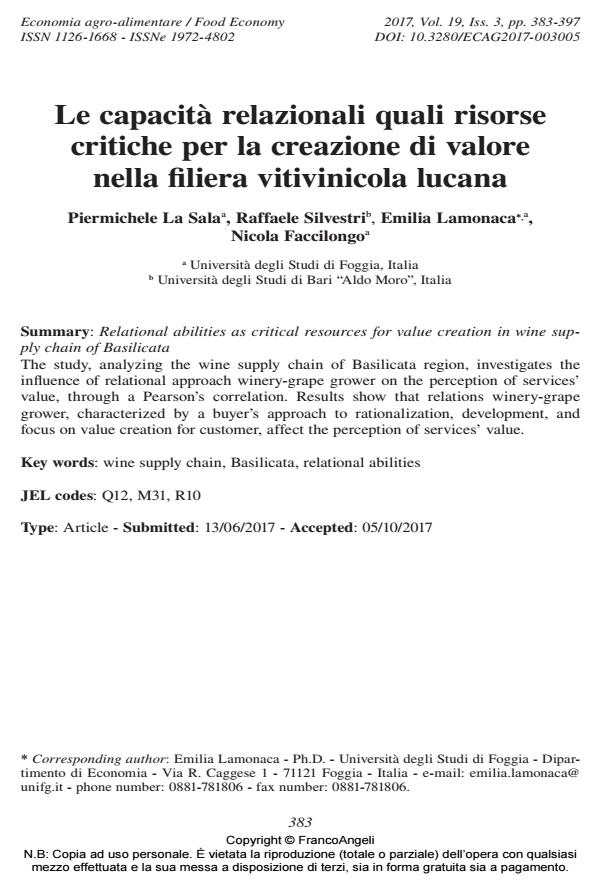Le capacità relazionali quali risorse critiche per la creazione di valore nella filiera vitivinicola lucana
Titolo Rivista ECONOMIA AGRO-ALIMENTARE
Autori/Curatori Piermichele La Sala, Raffaele Silvestri, Emilia Lamonaca, Nicola Faccilongo
Anno di pubblicazione 2017 Fascicolo 2017/3 Lingua Italiano
Numero pagine 16 P. 383-398 Dimensione file 189 KB
DOI 10.3280/ECAG2017-003005
Il DOI è il codice a barre della proprietà intellettuale: per saperne di più
clicca qui
Qui sotto puoi vedere in anteprima la prima pagina di questo articolo.
Se questo articolo ti interessa, lo puoi acquistare (e scaricare in formato pdf) seguendo le facili indicazioni per acquistare il download credit. Acquista Download Credits per scaricare questo Articolo in formato PDF

FrancoAngeli è membro della Publishers International Linking Association, Inc (PILA)associazione indipendente e non profit per facilitare (attraverso i servizi tecnologici implementati da CrossRef.org) l’accesso degli studiosi ai contenuti digitali nelle pubblicazioni professionali e scientifiche
;
Keywords:Wine supply chain, Basilicata, relational abilities
Jel codes:Q12, M31, R10
- Achrol, R.S. & Etzel, M.J. (2003). The structure of reseller goals and performance in marketing channels. Journal of the Academy of Marketing Science, 31(2), 146-163. DOI: 10.1177/0092070302250899
- Allen, I.E. & Seaman, C.A. (2007). Likert scales and data analyses. Quality Progress, 40(7), 64.
- Anderson, J.C., Narus, J.A. & Van Rossum, W. (2006). Customer value propositions in business markets. Harvard business review, 84(3), 90-99.
- Cantù, C., Corsaro, D., Fiocca, R. & Tunisini, A. (2013). imp studies: A bridge between tradition and innovation. Industrial Marketing Management, 42(7), 1007-1016.
- Capaldo, A. (2007). Network structure and innovation: The leveraging of a dual network as a distinctive relational capability. Strategic Management Journal, 28(6), 585-608.
- Dwyer, F.R. & Welsh, M.A. (1985). Environmental relationships of the internal political economy of marketing channels. Journal of Marketing Research, 22(4), 346-358. DOI: 10.2307/3151585
- Eisenhardt, K.M. & Graebner, M.E. (2007). Theory building from cases: opportunities and challenges. Academy of management journal, 50(1), 25-32. DOI: 10.5465/AMJ.2007.24160888
- Eisenhardt, K.M. (1989). Building theories from case study research. Academy of Management Review, 14(4), 532-550.
- Fiocca, R. (2014). Impresa futura. Nuove prospettive per l’impresa e il management del domani: Nuove prospettive per l’impresa e il management del domani. Milano: FrancoAngeli.
- Gersick, C.J. (1988). Time and transition in work teams: Toward a new model of group development. Academy of Management Journal, 31(1), 9-41. DOI: 10.2307/256496
- Håkansson, H. & Ford, D. (2002). How should companies interact in business networks?. Journal of business research, 55(2), 133-139. DOI: 10.1016/S0148-2963(00)00148-X
- Håkansson, H., Ford, D., Gadde, L.E., Snehota, I. & Waluszewski, A. (2009). Business in networks. London: Wiley and Sons.
- Håkansson, H. & Snehota, I. (1989). No business is an island: the network concept of business strategy. Scandinavian Journal of Management, 5(3), 187-200. DOI: 10.1016/0956-5221(89)90026-2
- Håkansson, H. & Snehota, I. (1995). Developing relationships in business networks. London: Routledge.
- Heide, J.B. & John, G. (1990). Alliances in industrial purchasing relationships: the determinants of joint action in buyer-seller relationships. Journal of Marketing Research, 27(1), 24-36. DOI: 10.2307/3172548
- Hennig-Thurau, T., Gwinner, K.P. & Gremler, D.D. (2002). Understanding relationship marketing outcomes: an integration of relational benefits and relationship quality. Journal of Service Research, 4(3), 230-247. DOI: 10.1177/1094670502004003006
- Hoang, H. & Antoncic, B. (2003). Network-based research in entrepreneurship: a critical review. Journal of Business Venturing, 18(2), 165-187. DOI: 10.1016/S0883-9026(02)00081-2
- Istituto Nazionale di Statistica [istat] (2010). Agricoltura e zootecnia, consultazione dati. -- Agri.Istat.agri.istat.it/sag_is_pdwout/jsp/NewDownload.jsp?id=15A|18A|25A.
- Joshi, A.W. & Campbell, A.J. (2003). Effect of environmental dynamism on relational governance in manufacturer-supplier relationships: a contingency framework and an empirical test. Journal of Academy of Marketing Science, 31(2), 176-188. DOI: 10.1177/0092070302250901
- Kilkenny, M. & Fuller-Love, N. (2014). Network analysis and business networks. International Journal of Entrepreneurship and Small Business, 21(3), 303-316. DOI: 10.1504/IJESB.2014.060894
- Mattsson, L.G. (1997). “Relationship marketing” and the “markets as networks approach”-a comparative analysis of two evolving streams of research. Journal of Marketing Management, 13(5), 447-461. DOI: 10.1080/0267257X.1997.9964485
- Nuzzo, V. (2015). La filiera viti-vinicola in Basilicata. Vitenda. -- www.viten.net/viticoltura/la-filiera-viti-vinicola-in-basilicata.
- Porter, M. (1985), Competitive Strategy. New York: Free Press.
- Stump, R.L. & Heide, J.B. (1996). Controlling supplier opportunism in industrial relationships. Journal of Marketing Research, 33(4), 431-441. DOI: 10.2307/3152214
- Teece, D.J., Pisano, G. & Shuen, A. (1997). Dynamic capabilities and strategic management. Strategic management journal, 18(7), 509-533.
- Teece, D. & Pisano, G. (1994). The dynamic capabilities of firms: an introduction. Industrial and corporate change, 3(3), 537-556.
- Yin, R.K. (2009). Case study research: Design and methods (4th ed.). Thousand Oaks, CA: Sage.
- Ecosystem for Successful Agriculture. Collaborative Approach as a Driver for Agricultural Development Nino Adamashvili, Mariantonietta Fiore, Francesco Contò, Piermichele La Sala, in European Countryside /2020 pp.242
DOI: 10.2478/euco-2020-0014
Piermichele La Sala, Raffaele Silvestri, Emilia Lamonaca, Nicola Faccilongo, Le capacità relazionali quali risorse critiche per la creazione di valore nella filiera vitivinicola lucana in "ECONOMIA AGRO-ALIMENTARE" 3/2017, pp 383-398, DOI: 10.3280/ECAG2017-003005